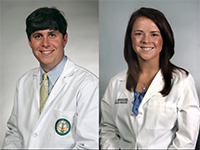 This year, the annual Department of Orthopaedic Surgery Resident Research Day looked a bit different, but the mission of supporting the research efforts of residents remains the same.
This year, the annual Department of Orthopaedic Surgery Resident Research Day looked a bit different, but the mission of supporting the research efforts of residents remains the same.
The event was completely virtual, and residents presented their research topics over Zoom. The event gave chief residents the opportunity to present their own research projects and discuss their topics with a virtual audience.
After a welcome from Department of Orthopaedic Surgery Chair Steven Theiss, M.D., and Executive Vice Chair Shawn Gilbert, M.D., Sports Medicine Section Chief Amit Momaya, M.D., introduced John Tokish, M.D., an orthopedic surgeon at Mayo Clinic, Arizona.
Following a presentation by Tokish, the chief residents shared their own research as follows:
- Jonathon Yu, M.D.: The Management of Pelvic Ring Injuries with Concomitant Urogenital Trauma
- Zane Hyde, M.D.: Partial Rotator Cuff Repair Versus Debridement for Irreparable Rotator Cuff Tears: A Systematic Review
- Christopher Odom, M.D.: Radiographic Outcomes of Single Screw Fixation in Unstable Lateral Compression Pelvic Ring Injuries
- Allison Hunter, M.D.: Staples versus sutures in hand and wrist surgery: a prospective, blinded, randomized controlled study
- Jeffrey Pearson, M.D.: Thrombin Hemostatic Matrix Reduces Heterotopic Ossification in Acetabular Fractures fixed via the Kocher-Langenbeck Approach
- Matthew Christie, M.D.: Risk factors for acute thigh compartment syndrome
Tokish and department leaders then selected two winners: Hunter and Pearson.
Hunter’s study was a prospective, blinded, randomized controlled study comparing the use of staples versus sutures in linear skin incisional closures for elective hand and wrist surgery. The study showed staples to be twice as fast as sutures in the operating room with comparable pain scores, cosmetic outcome, wound complications and materials removal time in the clinic.
Pearson’s research was a retrospective review of operatively treated acetabulum fractures fixed via the kocher langenbach approach showed surgiflo use resulted in statistically significant decreased rates of heterotopic ossification. Surgiflo is a thrombin matrix which has been shown to increase plasmin production. Their results build on other studies showing the interaction of the plasmin pathway and heterotopic ossification formation.
Theiss is proud of the work of all residents and their adaptation to presenting virtually this year.
“Although our annual event was in a new format, it was still just as wonderful to see the hard work of residents culminate into their research presentations,” said Theiss. “The entire department is thankful to our 2020 chiefs and looks forward to all that they will accomplish.”